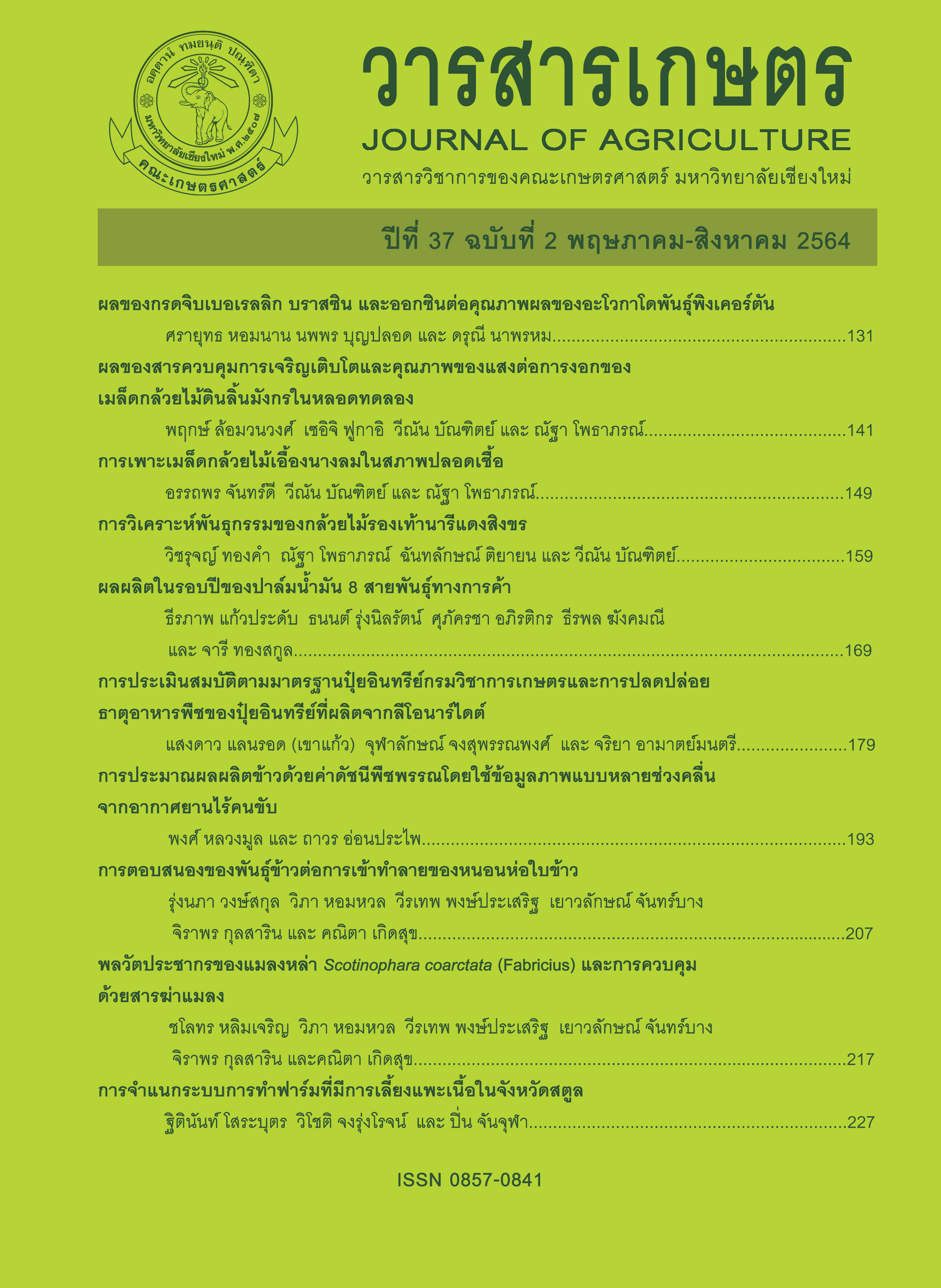ผลของสารควบคุมการเจริญเติบโตและคุณภาพของแสงต่อการงอกของเมล็ดกล้วยไม้ดินลิ้นมังกรในหลอดทดลอง
Main Article Content
บทคัดย่อ
เมล็ดกล้วยไม้ดินลิ้นมังกรมีอัตราการงอกต่ำ ถึงแม้ว่าจะนำมาเพาะในสภาพปลอดเชื้อ การทดลองนี้มีวัตถุประสงค์เพื่อศึกษาวิธีการเพิ่มอัตราการงอกของเมล็ดกล้วยไม้ลิ้นมังกร โดยทำการศึกษา 2 ชุดการทดลอง ชุดการทดลองที่ 1 ศึกษาผลของสารควบคุมการเจริญเติบโตต่อการงอกของเมล็ด โดยแช่เมล็ดในสารควบคุมการเจริญเติบโต ได้แก่ α - naphthaleneacetic acid (NAA), 6 - benzylaminopurine (BAP) และ เอทธิฟอน ที่ระดับความเข้มข้นต่าง ๆ กัน เป็นเวลา 24 ชั่วโมง จากนั้นนำไปเพาะบนอาหารสูตร Malmgren modified terrestrial orchid medium (MM) จากผลการทดลอง พบว่า การแช่เมล็ดในสารควบคุมการเจริญเติบโต NAA ที่ระดับความเข้มข้น 0.1 มิลลิกรัมต่อลิตร, BAP 1.0 มิลลิกรัมต่อลิตร และ เอทธิฟอน 10.0 มิลลิกรัมต่อลิตร ส่งเสริมอัตราการงอกของเมล็ดกล้วยไม้ลิ้นมังกรได้ดีกว่าอย่างมีนัยสำคัญทางสถิติ เมื่อเทียบกับชุดการทดลองที่ไม่ใช้สารควบคุมการเจริญเติบโต ชุดการทดลองที่แช่เมล็ดในสารละลาย NAA ที่ระดับความเข้มข้น 1.0 และ 10.0 มิลลิกรัมต่อลิตร และ ชุดการทดลองที่แช่เมล็ดในสารละลาย BAP ที่ระดับความเข้มข้น 0.1 มิลลิกรัมต่อลิตร การทดลองที่ 2 ทำการทดสอบประสิทธิภาพของแสงต่อการงอกของเมล็ดโดยเพาะเมล็ดบนอาหารสูตร Murashige and Skoog (MS) ภายใต้แสงที่มีความยาวคลื่นแตกต่างกัน 6 แบบ ที่ระดับ ความเข้มแสง 5.0 μmol m-2 s-1 และชุดควบคุม (สภาพมืด) ตลอดเวลา เมื่อผ่านไป 2 เดือน พบว่า เมล็ดที่เพาะไว้ในที่มืด แสงสีม่วง (405 นาโนเมตร) แสงสีเขียว (546 นาโนเมตร) และแสงสีเหลือง (595 นาโนเมตร) มีอัตราการงอกของเมล็ดที่สูงกว่าเมล็ดที่เพาะภายใต้แสงไกลแดง อย่างมีนัยสำคัญทางสถิติ
Article Details
เอกสารอ้างอิง
Baque, M.A., Y.K. Shin, T. Elshmari, E.J. Lee and K.Y. Paek. 2011. Effect of light quality, sucrose and coconut water concentration on the micropropagation of Calanthe hybrids (‘Bukduseong’ × ‘Hyesung’ and ‘Chunkwang’ × ‘Hyesung’). Australian Journal of Crop Science 5(10): 1247-1254.
Batty, A.L., M.C. Brundrett, K.W. Dixon and K. Sivasithamparam. 2006. New methods to improve symbiotic propagation of temperate terrestrial orchid seedlings from axenic culture to soil. Australian Journal of Botany 54(4): 367-374.
Bradbeer, J.W. 1988. Seed Dormancy and Germination. Blackie and Son Ltd., Glasgow. 145 p.
Contreras, S., M.A. Bennett, J.D. Metzger, D. Tay and H. Nerson. 2009. Red to far-red ratio during seed development affects lettuce seed germinability and longevity. HortScience 44(1): 130-134.
Dutra, D., M.E. Kane and L. Richardson. 2009. Asymbiotic seed germination and in vitro seedling development of Cyrtopodium punctatum: a propagation protocol for an endangered Florida native orchid. Plant Cell, Tissue and Organ Culture 96: 235-243.
Fukai, S., K. Fujiwara, K. Okamoto, A. Hasegawa and M. Goi. 1997. Effects of red and blue light on germination and protocorm growth of Calanthe Satsuma. Lindleyana 12(4): 169-171.
Islam, M.O., S. Matsui and S. Ichihashi. 1999. Effects of light quality on seed germination and seedling growth of Cattleya orchids in vitro. Journal of The Japanese Society for Horticultural Science 68(6): 1132-1138.
Kauth, P.J., W.A. Vendrame and M.E. Kane. 2006. In vitro seed culture and seedling development of Calopogon tuberosus. Plant Cell, Tissue and Organ Culture 85: 91-102.
Kurzweil, H. 2009. The genus Habenaria (Orchidaceae) in Thailand. Thai Forest Bulletin (Special issue): 7-105.
Miyoshi, D. and M. Mii. 1995. Phytohormone pre-treatment for the enhancement of seed germination and protocorm formation by the terrestrial orchid, Calanthe discolor (Orchidaceae), in asymbiotic culture. Scientia Horticulturae 63: 263-267.
Mohr, H. and P. Schopfer. 1995. Plant Physiology. Springer-Verlag, Berlin. 629 p.
Murashige, T. and F. Skoog. 1962. A revised medium for rapid growth and bio-assays with tobacco tissue cultures. Physiologia Plantarum 15: 473-497.
Nakamura, S.J., T. Uchida and M. Hamada. 1975. Atmospheric condition controlling the seed germination of an achlorophyllous orchid, Galeola septentrionalis. The Botanical Magazine 88: 103-109.
Nigel, D.S. and K.W. Dixon. 2009. Terrestrial orchid conservation in the age of extinction. Annals of Botany 104(3): 543-556.
Piyatrakul, P. 2004. Factors influencing germination and seedling development of Habenaria rhodocheila Hance. Ph.D. Thesis. Chiang Mai University, Chiang Mai 171 p. (in Thai)
Rasmussen, H.N. 1995. Terrestrial Orchids: From Seed to Mycotrophic Plant. Cambridge University Press, Cambridge. 444 p.
Rasmussen, H.N., T.F. Andersen and B. Johansen. 1990. Light stimulation and darkness requirement for the symbiotic germination of Dactylorhiza majalis (Orchidaceae) in vitro. Physiologia Plantarum 79: 226-230.
Royal Botanical Gardens, Kew. 2017. Habenaria willd. (Online). Available: http://www.plantsofthe worldonline.org/taxon/urn:lsid:ipni.org:names:638021-1 (January, 28, 2018).
Shin, Y.K., M.A. Baque, S. Elghamedi, E.J. Lee and K.Y. Paek. 2011. Effects of activated charcoal, plant growth regulators and ultrasonic pre-treatments on in vitro germination and protocorm formation of Calanthe hybrids. Australian Journal of Crop Science 5(5): 582-588.
Stewart, S.L. 2007. Intergrated conservation of florida Orchidaceae in the genera Habenaria and Spiranthes: Model orchid conservation systems for the Americas. Ph.D. Thesis. University of Florida, Gainesville. 226 p.
Stewart, S.L. and M.E. Kane. 2006. Asymbiotic seed germination and in vitro seedling development of Habenaria macroceratitis (Orchidaceae), a rare Florida terrestrial orchid. Plant Cell, Tissue and Organ Culture 86: 147-158.


